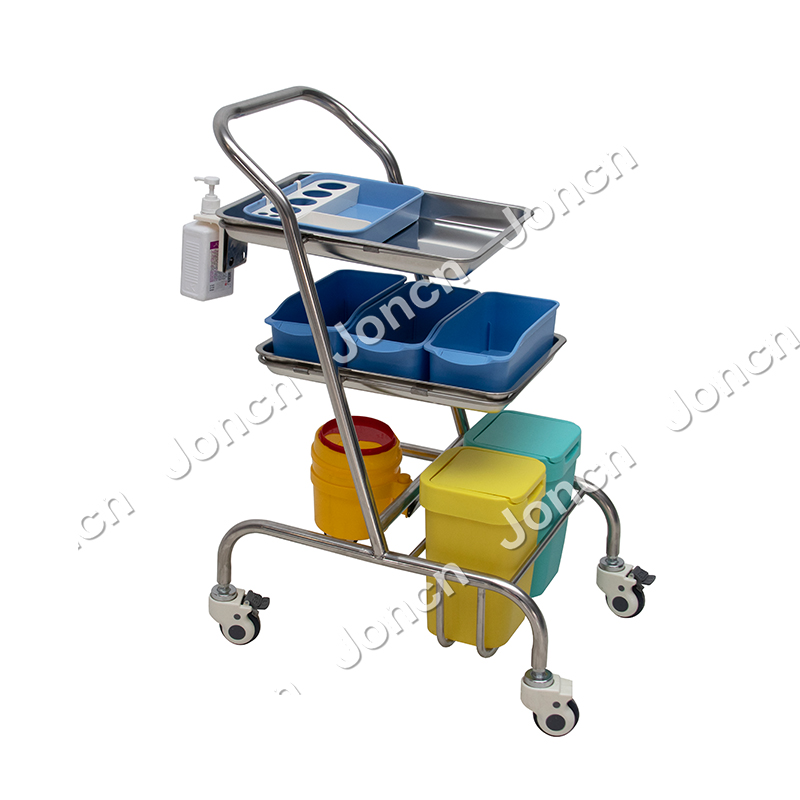
Why Stainless Steel?
Stainless steel has long been the material of choice in medical equipment for several reasons. It is not only highly resistant to corrosion but also has the ability to withstand rigorous cleaning and disinfection procedures, making it ideal for maintaining hygiene standards in medical settings.
The sleek, polished finish of stainless steel also makes it a more aesthetically pleasing choice, contributing to a cleaner and more organized healthcare environment. This is important in clinical settings where both function and appearance play a role in creating a calm, professional atmosphere for patients and staff alike.
Key Features to Consider When Choosing a Medical Stainless-Steel Trolley
Design and Layout
The design of the trolley should align with the specific needs of your facility. Do you need a trolley with multiple shelves and compartments for different supplies, or a simple, single-level unit for easy access? A modular design can provide flexibility, allowing for adjustments in configuration based on evolving requirements. Whether you need a small medication trolley or a large multi-functional surgical trolley, the design should accommodate the type and volume of supplies you'll be transporting or storing.
Load Capacity
Medical trolleys are used to transport and store equipment, medications, and supplies that can vary in weight. Choose a trolley with the appropriate load capacity to avoid overloading and ensure the safety of both the trolley and the healthcare workers using it. For example, medication trolleys typically don’t carry as much weight as surgical instrument trolleys, which need to support heavier and more specialized equipment.
Mobility and Locking Mechanism
Mobility is key in fast-paced medical environments, and medical stainless-steel trolleys are often equipped with swivel wheels for easy movement. However, ensure the wheels are made of high-quality materials to endure the constant movement across various surfaces, including potentially wet or uneven floors. Additionally, many trolleys come with a locking feature, which ensures stability when the trolley is not in use or needs to be kept stationary during procedures.
Ergonomics
Trolleys should be designed for ease of use, minimizing the physical strain on medical personnel. Ergonomic handles or push bars can make maneuvering the trolley easier, especially during long shifts. The height of the trolley should also be considered, as staff may need to bend down or stretch to access supplies. Adjustable height features can further improve accessibility and comfort.

Size and Storage Capacity
The size of the trolley is an important factor in its suitability for different medical applications. A trolley for storing large medical instruments, such as surgical equipment, will require more space and different shelving compared to one used for transporting medications. Consider the specific needs of your facility and choose trolleys with the right storage configuration.
Maintenance and Cleaning
Stainless steel is easy to clean, but the design of the trolley can affect how well it can be disinfected. Look for models with smooth surfaces and minimal seams or joints, as these are easier to wipe down and sanitize. The more intricate the design, the harder it may be to properly clean.
Types of Medical Stainless-Steel Trolleys
Surgical Trolleys: These trolleys are designed to carry surgical instruments, sterilizers, and other essential tools required during operations. A well-organized surgical trolley reduces the time required to access necessary equipment, which is critical in high-pressure situations.
Emergency Trolleys: Equipped with life-saving equipment such as defibrillators, oxygen masks, and bandages, emergency trolleys are a staple in ERs and trauma units. They must be readily accessible, well-organized, and durable enough to handle the rigors of constant movement.
Medication Trolleys: Medication trolleys are used to store and transport medications to patients. These trolleys often have multiple compartments, lockable drawers, and dedicated areas for different types of medications, ensuring safe and efficient drug administration.
Utility Trolleys: Designed for more general purposes, utility trolleys are often used to transport medical supplies, cleaning materials, or equipment between rooms. They are versatile and come in various sizes, depending on the intended use.

OBT-B07adjustable movable overbed dining table, designedfor both hospital and home use. With dimensions of 800400725/965mm, this versatile table is equipped with a dining plate and four sturdy casters...
See Details
Folding aluminum alloy ambulance wheelchair stretcher, model ST200025. Designed for functionality and convenience, this stretcher excels in narrow spaces like elevators, easily transitioning from a fu...
See Details
ABS material manual emergency patient transfer trolley, designed for seamless and efficient patient transport within hospital premises. This versatile trolley boasts Technical Parameters of 1900x640x(...
See Details
Electrical operation room bed for hospital surgeries use, designed to elevate surgical precision and patient comfort to new heights. This operating table boasts a comprehensive range of technical feat...
See Details
Our economic emergency medical trolleys are designed with multiple compartmentalized drawers and trays, with each area dedicated to storing a specific type of medical supplies. From oxygen masks, endo...
See Details
This humanized design emergency trolley is ergonomically designed to provide a comfortable hold even in emergencies. Buttons on the handles make it easy to lock or unlock the wheels, allowing the stro...
See DetailsIf you are interested in our products, please consult us
Products
Mobile terminal